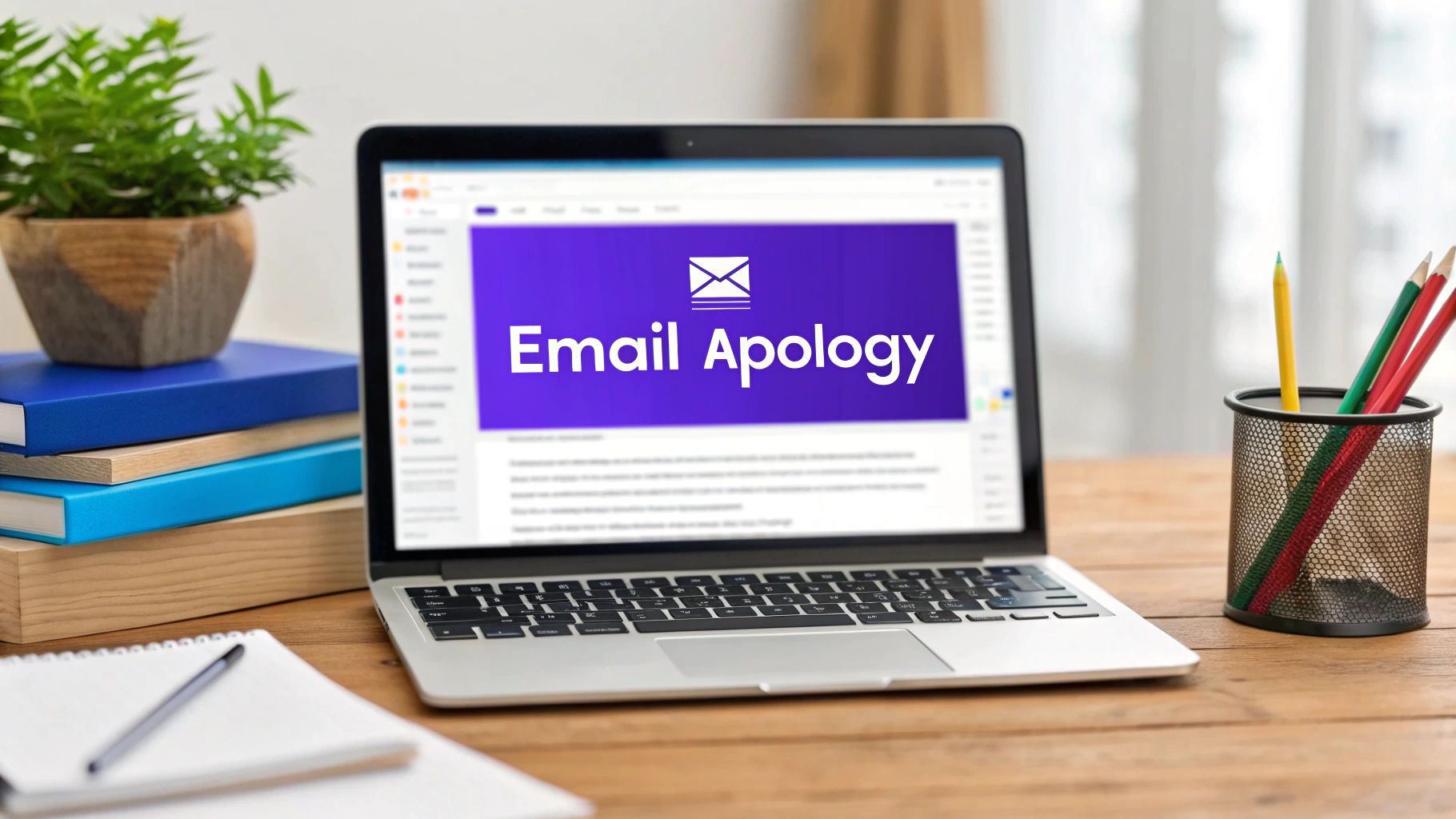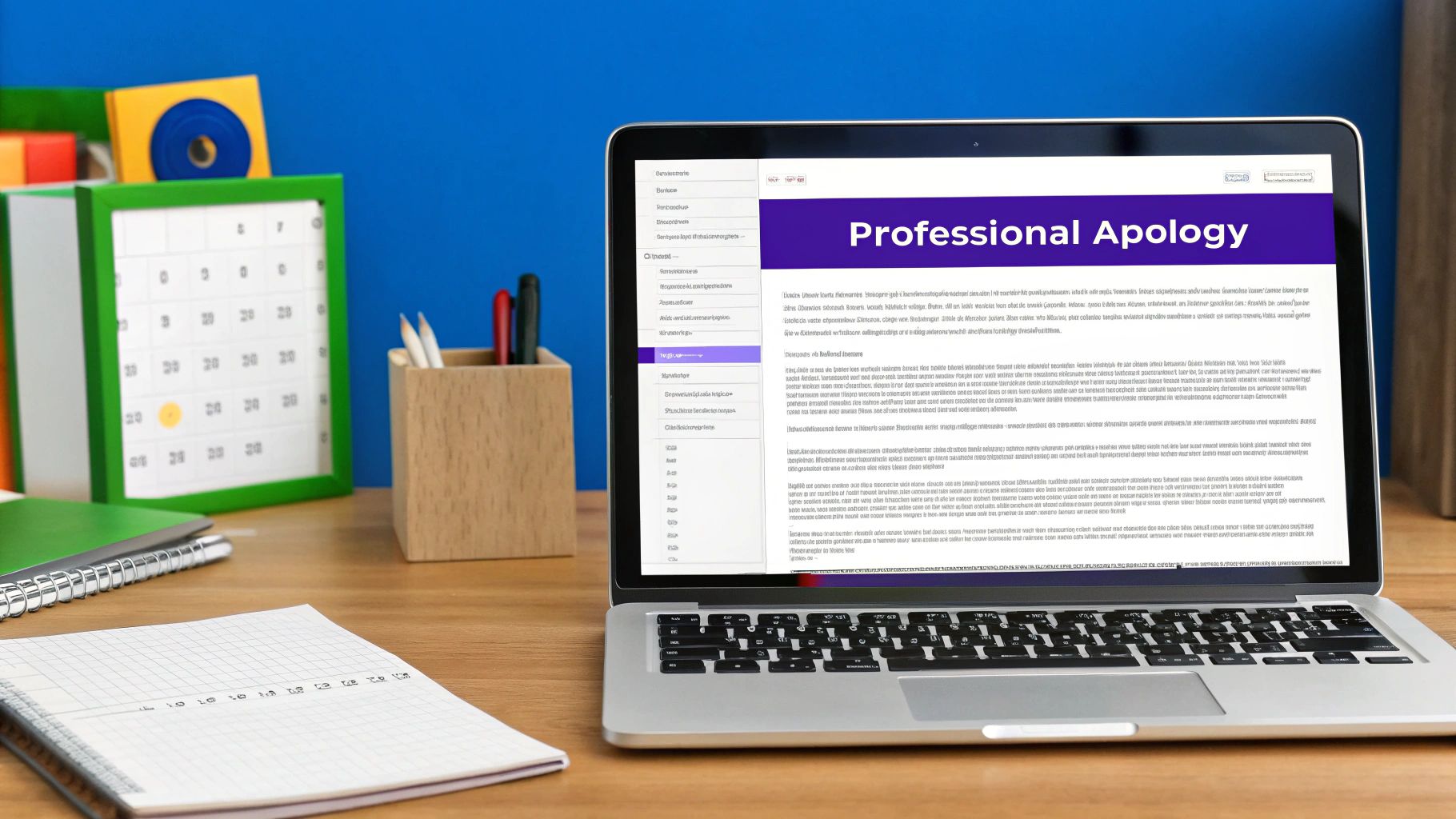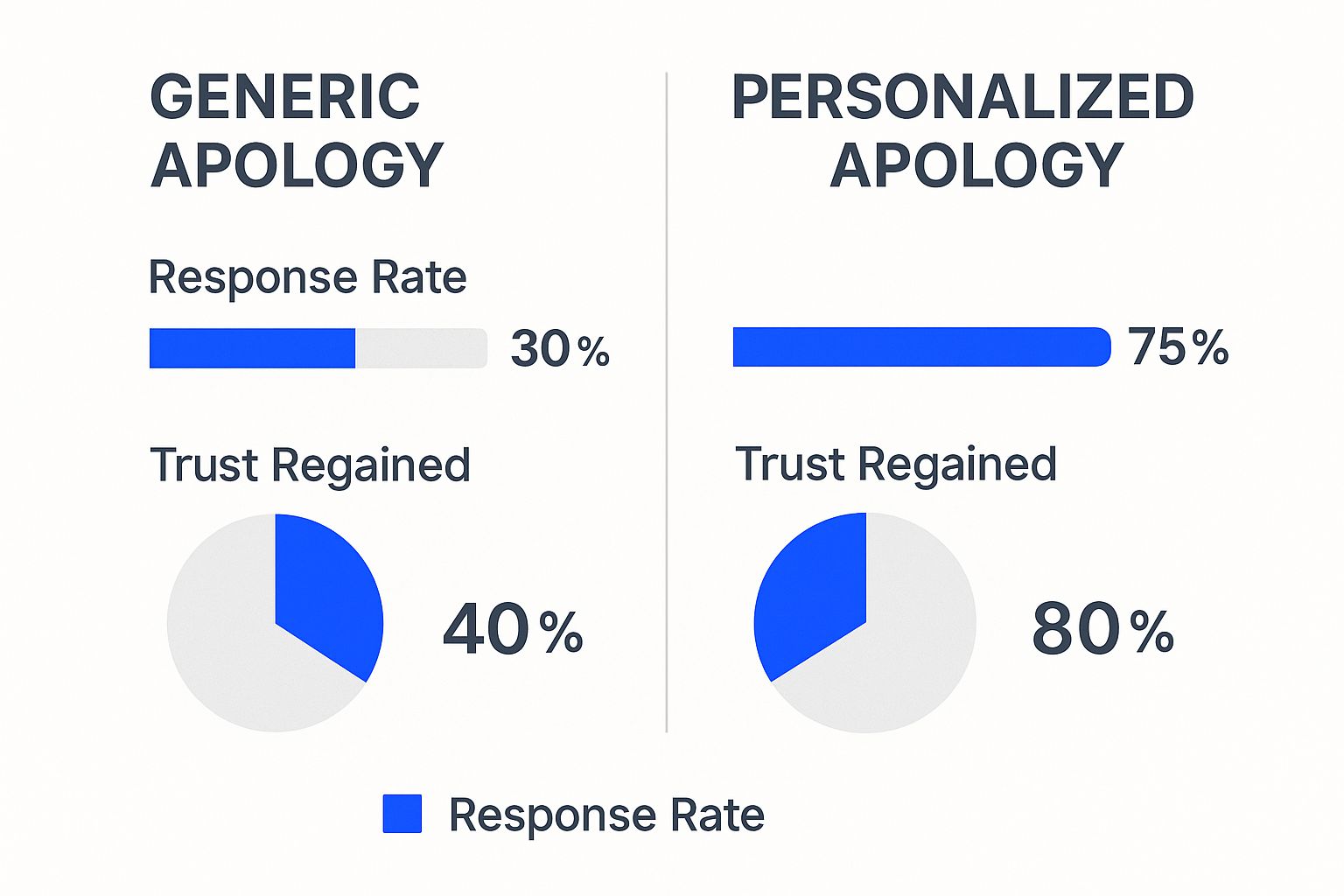How to Apologize Professionally in an Email | Tips & Templates
Discover the essential components of a professional apology email, including how to acknowledge mistakes, express remorse, and take responsibility. This guide provides practical tips, common pitfalls to avoid, and templates for various scenarios to help you rebuild trust and improve workplace communication.

The Real Impact of Professional Apologies

Owning up to mistakes in a professional setting can certainly feel uncomfortable. However, it's a crucial part of maintaining your integrity and keeping work relationships healthy. Understanding the reasons behind a professional apology shows just how beneficial it can be, particularly when carefully crafted in an email.
Why Email Apologies Carry Weight
Email often acts as the go-to method for formal communication in the workplace, making it an important way to handle errors. It creates a written record and gives both the person sending and receiving the apology time to consider the message properly.
Research looking at corporate apologies between 2020-2024 backs this up. Email was the preferred method in 68% of B2B communications, far outpacing phone calls (22%) or face-to-face apologies (10%). Some industries, like finance, have even made this standard practice; reportedly, 90% of UK banks use set templates for addressing complaints via email. Find more detailed statistics here
This common practice underscores the importance of knowing how to apologize professionally in an email. It’s more than just saying "sorry"; it involves using this channel correctly to show genuine regret and accountability, especially when meeting in person isn't practical or suitable.
Strengthening Relationships Through Accountability
It might seem counterintuitive, but handling a mistake well can actually make professional connections stronger. Think of it as mending something broken – if done right, the fix can make it more solid than before. A heartfelt apology shows humility, respect, and a dedication to the relationship, potentially turning a misstep into a chance to build trust.
The effectiveness hinges on the psychology of a genuine apology. Clearly admitting fault, expressing sincere regret without making excuses, and taking responsibility validates the other person's feelings. This validation can ease friction and encourage understanding. Therefore, mastering the art of the professional email apology isn't just about damage control; it's a key skill for fostering positive, lasting relationships and protecting both your reputation and that of your company.
Crafting Apologies That Actually Work

Going further than a quick "I'm sorry," apologies that truly hit the mark in a professional setting need a few specific components to smooth things over and keep trust intact. Understanding how to apologize professionally in an email isn't just about saying you messed up; it's about showing you understand your responsibility and feel regret, doing so in a clear and helpful way. This approach can turn potential fallouts into chances to build stronger working relationships.
Key Elements of an Effective Apology Email
A meaningful apology relies on several important parts. First, you need to acknowledge the specific mistake clearly, leaving no room for doubt. Fuzzy apologies come across as half-hearted and make the other person question if you really get what went wrong. Don't just say "sorry for the hassle"; point out exactly what trouble you caused. This shows you've thought about the situation.
Next, it's crucial to express genuine remorse. This is more than just saying you regret something; your tone needs to show you understand how your actions affected the person or the project. Steer clear of words that sound stiff or insincere. Showing this kind of emotional intelligence is vital for proving you value the professional connection and understand the results of your mistake.
Lastly, you must take full responsibility. Fight the urge to make excuses, point fingers, or get defensive, even if the situation was complicated. Owning your role demonstrates integrity and shows you're focused on fixing things. When writing your apology, also think about who you're writing to; you might need to adjust your tone, especially when Dealing with Difficult Staff.
Structuring Your Message for Impact
The way you organize your apology email really affects how clearly it comes across and how well it's received. Studies show certain elements help resolve issues. Speed matters; acknowledgment within 24 hours was part of 78% of workplace problems that were successfully sorted out in one study. Good apologies also clearly state the specific mistake and lay out concrete corrective actions to stop it from happening again. It's also interesting that research indicates people apologize at different rates based on what they consider offensive. Explore this topic further
Think about using this simple outline for your professional apology email:
- Direct Opening: Begin right away with a clear apology for the specific issue.
- Specific Acknowledgment: Explain exactly what you're apologizing for, showing you grasp the error.
- Taking Responsibility: Clearly state your part in it without trying to shift blame.
- Expressing Remorse: Say you regret the impact your actions had.
- Action Plan: Describe the clear steps you will take to fix the problem or make sure it doesn't happen again.
- Professional Closing: Reaffirm your dedication to working together positively and sign off courteously.
Using these ideas consistently can change difficult situations into moments that strengthen your professional ties. You might find these Tools to Help Compose Your Apology Email useful.
Subject Lines That Get Your Apology Read

Even the most carefully worded apology won't matter if no one opens the email. That's why the subject line is so critical – it's the very first impression and determines if your message gets noticed or lost. Getting this right is a fundamental part of understanding how to apologize professionally in an email, making sure your apology has a chance to be heard.
The Power of Personalization and Tone
Forget generic subject lines; they tend to disappear in busy inboxes, particularly when the topic is sensitive. Adding a personal touch can significantly boost your chances. Studies show that emails with personalized subject lines (like "Sarah, My Apologies for the Mix-up Yesterday") see 40% higher open rates than those without.
Striking the right tone is equally important, yet tricky. Global workplace communication surveys found that 55% of professionals find it challenging to sound accountable without coming across as defensive. Discover more insights about email personalization and tone. You need to show you're taking responsibility, but avoid dramatic language that puts the reader on guard. The aim is to encourage them to open the email feeling receptive, not defensive.
Decoding Effective Subject Lines: Insights from Data
The words you choose for your subject line have a real impact. Analyzing numerous professional apology emails reveals distinct patterns in what works best to grab attention. The data chart visualized above helps illustrate the difference in open rates between various subject line strategies for apology emails.
This data indicates that subject lines clearly stating "Apology" or referencing the specific issue (e.g., "Apology Regarding Project Delay" or "Regarding the Error in Our Last Meeting") achieve much higher open rates, frequently topping 65%. In contrast, vague subjects like "Quick Question" or "Following Up" often perform poorly (sometimes under 25% open rates) when an apology is expected, simply because they don't signal the email's real intent. The preference is clearly for subject lines demonstrating direct accountability without excessive drama.
To better understand what works and what doesn't, let's compare some examples. This table breaks down effective versus ineffective approaches for apology email subject lines.
| Effective Subject Lines | Why They Work | Ineffective Subject Lines | Why They Fail |
|---|---|---|---|
| "Apology Regarding Project Deadline" | Direct, clear, references the specific issue. | "Quick Question" | Vague, misleading, doesn't convey the email's purpose |
| "Following Up on Our Meeting Error" | Specific, takes ownership, provides context. | "Checking In" | Ambiguous, easily ignored, lacks urgency or clarity |
| "[Name], My Sincere Apologies for [Issue]" | Personalized, direct, shows accountability, builds rapport. | "An Update" | Non-specific, could be about anything, low priority |
| "Correction: Information in Previous Email" | Clearly states the purpose (correction), addresses the mistake directly. | "Important Info" | Overused, often ignored, lacks specific context |
Table Title: Effective vs. Ineffective Apology Subject Lines Description: This table compares examples of effective and ineffective subject lines for apology emails, highlighting key differences in approach and potential impact.
As the table illustrates, clarity, specificity, and a tone of accountability are key ingredients for an effective apology subject line that prompts recipients to open and read your message.
Tips for Crafting Apology Subject Lines
Based on these findings, here are a few practical tips for writing subject lines that ensure your apology gets read:
- Be Direct and Clear: Don't beat around the bush. Use words like "Apology," "Correction," or "Regarding [Specific Issue]" so the purpose is immediately understood.
- Add Specificity (When Appropriate): Briefly mentioning the topic gives context (e.g., "Apology for the Delay in Sending the Report"). This helps the recipient prioritize.
- Maintain a Professional Tone: Steer clear of overly casual, emotional, or defensive phrasing. Keep it respectful and centered on the issue.
- Personalize Thoughtfully: Including the recipient's name can boost engagement, as mentioned earlier, making the apology feel more direct and sincere.
Nailing the subject line is a vital skill in professional communication. For more tips, you might want to explore resources on Mastering Email Subject Lines for Better Engagement. Getting this small detail right paves the way for a more effective apology and helps repair professional relationships.
Perfect Timing: When and How to Send Your Apology

While a strong subject line ensures your apology gets seen, when you actually send it greatly influences its reception. Sending a message too quickly without proper thought, or delaying it too long, can weaken even the most genuine apology. Knowing how to apologize professionally in an email absolutely includes getting the timing right.
Assessing Severity and Urgency
The kind of mistake you made usually sets the pace for your response. Small errors, like a minor typo in a routine document, might just need a quick fix. However, major blunders affecting projects or colleagues require a much swifter acknowledgment.
Immediate apologies show you're responsive, but sometimes pausing briefly to grasp the full situation allows for a more complete and helpful reply.
For significant mistakes impacting others, acknowledging the problem within 24 hours is generally recommended, even if the complete fix takes more time. This first contact demonstrates awareness and seriousness. Still, firing off an apology for a complicated issue before you understand it can come across as hollow.
Considering the Relationship Context
Who you are apologizing to also matters quite a bit. The expected timing and level of formality will vary depending on if it's your manager, a top executive, a colleague in another team, or a client. An apology to a senior figure might need more careful thought and a slightly more formal approach compared to a brief note to a teammate you work with every day.
Company culture plays a part too. Some workplaces prioritize speed above all, while others prefer a considered response. Watching how others handle errors can offer guidance, but timeliness is nearly always valued when correcting mistakes.
Individual vs. Group Apologies
The timing differs slightly if your apology is for one person versus a group. You can often send an individual apology fairly quickly after assessing the situation. Group apologies, on the other hand, might require more planning, especially if several people contributed to the error or the message needs approval.
When apologizing to a group, or if you can't offer an immediate solution, setting clear expectations is vital. Think about sending a quick initial note acknowledging the issue, followed by a promise to provide a fuller update or resolution by a certain time. This demonstrates accountability while buying you the time needed to handle the situation correctly.
In the end, picking the right moment is a strategic decision in the apology process. Finding the balance between being prompt and being thoughtful ensures your apology successfully mends relationships and rebuilds trust.
Industry-Specific Apology Strategies That Resonate
Knowing when to apologize is important, but how you say sorry can be just as critical, especially in the professional world. The approach that works wonders in a dynamic tech startup could easily backfire in a strictly regulated financial firm. Understanding these nuances is essential for making your professional email apology effective.
Why Apology Styles Vary Across Industries
Different work environments have their own unique communication styles and expectations. Things like regulatory oversight, the type of relationships you have with clients, and the level of potential risk all shape how apologies are received and what makes one land well. What's considered appropriate really depends on the specific pressures and priorities within your sector.
Take financial services or healthcare, for example. Apologies in these fields often bump up against strict compliance rules and the possibility of legal trouble. Being precise, using approved wording, and carefully thinking about liability are absolutely crucial. This contrasts sharply with creative industries, where maintaining a good relationship and showing empathy might matter more than sticking to formal rules. Tech and retail often sit somewhere in between, needing both quick responses and genuine understanding, particularly when dealing with customers.
Handling Regulations and Legal Concerns
Figuring out how to apologize professionally in an email gets tricky when legal or regulatory issues come into play. Directly admitting fault can carry serious weight in some fields. Because of this, apologies often need to walk a fine line – expressing sincere regret without putting the organization at undue risk.
In sectors with heavy regulation, apologies might lean towards acknowledging the customer's experience and explaining the steps being taken to fix things, rather than explicitly saying "we messed up." This is especially true in customer-facing roles where a poorly worded apology could directly impact the business. Aware of this, companies in English-speaking markets often use apology email templates to create consistent responses, particularly since research shows 32% of customers might walk away from a brand after just one negative interaction. You can read more about avoiding over-apologizing here.
Adaptable Strategies From Sector Examples
Looking at how apologies have played out – both successfully and unsuccessfully – within your own industry offers valuable lessons. Studying these cases helps you spot common mistakes and effective tactics suited to your field's specific sensitivities. While you shouldn't just copy others, you can identify useful frameworks:
- Gauge Formality: Adjust your tone to match industry norms. Finance and legal usually demand more formal language compared to tech or creative fields.
- Balance Speed and Detail: In industries like tech or retail where things move fast, a quick acknowledgment can be key. For healthcare or intricate B2B relationships, a more careful, detailed response might be better.
- Highlight Solutions: In almost any industry, outlining a clear plan for fixing the problem or preventing it from happening again makes an apology stronger. Focus on the concrete actions you are taking.
- Recognize Client Impact: Tailor your empathy to the specific consequences relevant to your sector – whether that’s financial loss, project setbacks, service interruptions, or personal hassle.
In the end, the best professional apologies aren't one-size-fits-all. By carefully considering the unique context of your industry, you can write messages that genuinely repair relationships and maintain your professional standing.
Ready-to-Use Templates for Common Mistake Scenarios
Figuring out how to phrase a professional apology email can be tough, but having a template helps. Think of these examples not as exact scripts, but as helpful guides to learn how to apologize professionally in an email. Every situation needs a personal touch, but these frameworks offer a solid start.
They provide a reliable structure for showing you're sorry and taking ownership in a work setting.
Understanding the Anatomy of an Effective Apology Template
Most effective apology emails follow a similar pattern. They acknowledge the problem, accept responsibility, and explain how things will improve. Knowing these key parts helps you adjust any template to fit your specific circumstances. These elements are crucial for rebuilding any trust that might have been damaged.
To help you craft your own message, here's a look at the typical structure of a strong professional apology email. This table breaks down each essential component and its purpose.
Professional Apology Email Structure A breakdown of the recommended structure for professional apology emails, including essential components and their purpose
| Email Component | Purpose | Best Practices | Things to Avoid |
|---|---|---|---|
| Clear Subject Line | Sets the tone and ensures the email is opened. | Be direct (e.g., "Apology Regarding...") and specific. Personalize if appropriate. | Vague or misleading subjects (e.g., "Quick Question"). |
| Direct Apology | Immediately states the purpose of the email. | Express sincere regret clearly and early. | Burying the apology deep in the email. |
| Specific Acknowledgment | Shows you understand exactly what went wrong. | Clearly name the mistake or issue without ambiguity. | Vague language or minimizing the error. |
| Taking Responsibility | Demonstrates accountability and ownership. | Use "I" statements (e.g., "I take responsibility for..."). | Blaming others, making excuses, defensive language. |
| Explanation (Optional) | Provides context, not excuses. | Briefly explain how it happened, focusing on process, not blame. | Over-explaining or sounding like you're justifying. |
| Plan for Prevention | Shows commitment to avoiding recurrence and rebuilds trust. | Outline concrete, specific steps you will take. | Vague promises without actionable detail. |
| Offer to Make Amends | Addresses immediate impact, especially for clients/customers. | Suggest specific solutions (e.g., correction, discount) where applicable. | Ignoring the impact on the recipient. |
| Professional Closing | Reinforces commitment and maintains a positive tone. | Reiterate value for the relationship, thank them for understanding. | Abrupt or overly casual sign-offs. |
Following this structure helps ensure your apology comes across as sincere, clear, and constructive.
Adapting Templates for Common Situations
Let's explore how this structure works for common workplace errors. Always tweak the wording based on who you're writing to and how serious the mistake was:
- Missed Deadline: Begin with a direct apology for the delay. Acknowledge the consequences (e.g., "I understand this impacted the project timeline"). Take responsibility, offer a brief explanation if needed, and outline how you'll prevent it next time (e.g., "I've updated my task management approach").
- Error in Information/Deliverable: Apologize clearly for the mistake (e.g., "My apologies for the incorrect figure in the report I sent"). Send the correct information right away. Briefly explain the oversight and detail preventative steps (e.g., "I've implemented an extra review step before sending documents").
- Miscommunication: Say sorry for any confusion caused (e.g., "I apologize if my last email was unclear"). Restate your point or understanding clearly. Accept your part in the mix-up and suggest a way forward (e.g., "Would a brief call help us get on the same page?").
Remember, these frameworks are just starting points. Genuinely effective apologies always require personalization. Think about your relationship with the recipient – an apology to your manager will likely sound different than one to a peer.
The specific words you choose are important. They show respect and demonstrate you understand the other person's viewpoint, which is essential for rebuilding trust. Small adjustments in tone and phrasing can significantly change how your apology is received.
Rebuilding Trust After Your Apology
Sending a thoughtful apology email is a vital starting point, but the real work begins after you hit send. A genuine apology can open the path to making things right, but rebuilding trust requires ongoing effort and visible change. It's the actions you take after your apology that truly repair professional relationships.
Demonstrating Commitment to Change
Trust isn't rebuilt instantly; it's earned back through consistent behavior that matches your words. If your apology was for missing a deadline, make absolutely sure future deadlines are met. If the problem involved unclear communication, actively work on being more precise in your interactions.
Think of it like this: the apology patches the immediate hole, but consistent positive actions reinforce the relationship and prevent future problems.
Showing you're serious can involve practical steps:
- Keeping project management tools updated without delay.
- Using new checklists or review steps for tasks where errors occurred previously.
- Letting relevant colleagues or managers know about the preventive measures you've adopted.
These steps offer solid evidence that you are committed to preventing the issue from happening again.
Following Up Appropriately
A short, well-timed follow-up can strengthen the sincerity of your apology. Avoid overwhelming the recipient, but a simple check-in after some time has passed (the duration depends on the situation's seriousness) shows you're still mindful. For instance, you could say, "I just wanted to check in and reaffirm my commitment to making sure [the issue] doesn't repeat. Please let me know if you have any further concerns."
Knowing how to apologize professionally in an email is important, but the follow-through truly dictates the long-term outcome. Businesses understand this well. Many companies, particularly in English-speaking markets, use apology templates because mishandling apologies can lead to customer churn. Research shows 32% of customers might abandon a brand after only one negative experience. You can explore this topic further on HBR. This underscores why genuine efforts to rebuild trust are essential after the apology itself.
Gauging Acceptance and Preventing Future Issues
How can you tell if your apology was received well and trust is starting to mend? Pay attention to communication patterns and the overall professional atmosphere. If interactions still feel strained, it might be necessary to address it constructively. Sometimes, getting a better understanding requires asking for input directly, provided the relationship supports it. You might be interested in: Mastering the Art of Requesting Feedback for tips on handling these conversations effectively.
Ultimately, turning a mistake into a learning opportunity involves implementing systemic changes where possible, beyond just personal adjustments. Appropriately sharing the lessons learned can even bolster team procedures and help others avoid similar pitfalls. This transforms an individual error into a chance for group improvement. True accountability goes beyond the apology and includes proactive steps for prevention.
Rebuilding trust requires patience and consistent effort, starting with that first, carefully worded apology. Let quiky.email's free AI tools help you craft the perfect professional apology message effortlessly, generating sincere and effective apologies in seconds.
Key Takeaways
Essential learnings that you should remember from this article
- Understanding the importance of professional apologies in maintaining workplace relationships.
- Key elements of an effective apology email: acknowledgment, remorse, responsibility, and action plan.
- The significance of timing and subject lines in ensuring your apology is received positively.
Practical Tips
Actionable tips you can apply immediately to improve your email performance
Use a Clear Subject Line
Make sure your subject line clearly states the purpose of your email, such as 'Apology Regarding [Specific Issue]'. This increases the chances of your email being opened.
Acknowledge the Mistake Clearly
Be specific about what you are apologizing for to show that you understand the impact of your actions.
Follow Up After Your Apology
Check in with the recipient after some time to demonstrate your commitment to change and rebuilding trust.
Common Mistakes to Avoid
Pitfalls and misconceptions to avoid when writing persuasive emails
- Being vague about the mistake you are apologizing for.
- Using a generic subject line that doesn't convey the email's intent.
- Failing to take responsibility or making excuses in your apology.
Tools to Apply These Concepts
Put what you've learned into practice with these specialized tools
Related Content
Continue exploring with these related articles and tools